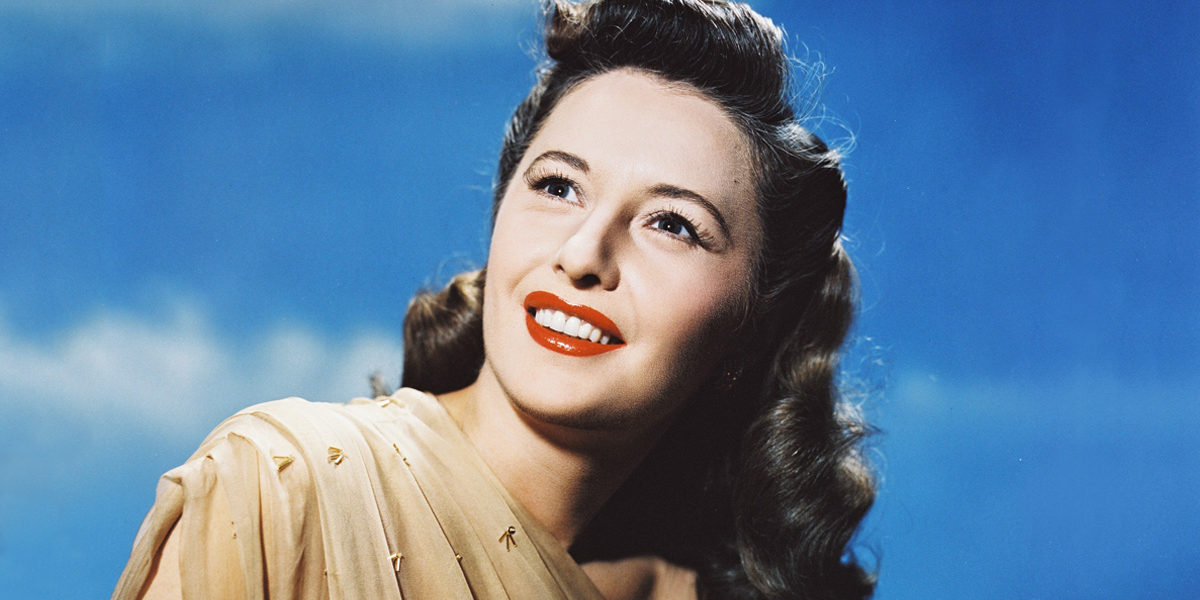Cold as Ice, Warm as the Sun
Welcome to the inaugural entry in our new Film Admissions column!
Each time (monthly, or thereabouts), all ZekeFilm contributors are invited and encouraged to watch a film that he or she has never seen before which stars an assigned actor, then write a short bit about the impression it left. The more noteworthy the admission, the better! Because all of us, even the most cinema savvy, have glaring holes in our personal filmographies. Why not publicly embrace that fact, and celebrate seeing some noteworthy movies for the first time? And you can play along at home!
This month, it’s films starring the amazing, adored, and enduring Barbara Stanwyck!
Stella Dallas
(1937, Samuel Goldwyn Productions, dir. King Vidor)
by Justin Mory
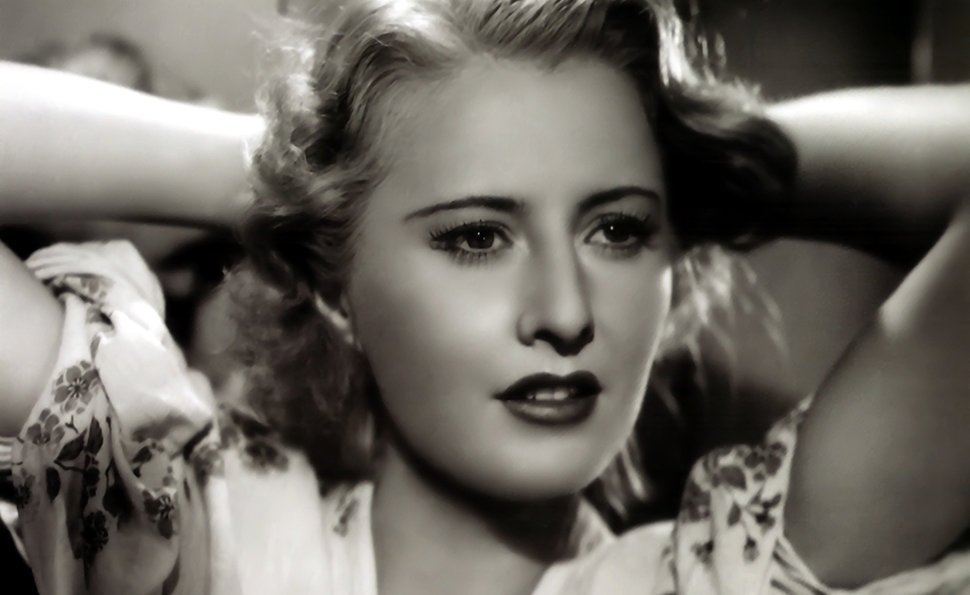
 A quick perusal of Barbara Stanwyck’s biography on Wikipedia reveals a brash, ambitious, and supremely capable woman not unlike the characters she would become famous for playing. Born Ruby Catherine Stevens in Brooklyn, New York, she was orphaned at a young age, left school to work at age 14, dreamed of breaking into show business, successfully auditioned for Florenz Ziegfeld and others a couple years later, by which time she was a working chorus girl in theatres, night clubs, and revues—all while training for larger parts on Broadway. Hollywood beckoned after the success of her first starring role, in the 1927 Broadway play, Burlesque, and 19-year-old Ruby, who had by this point taken the stage name “Barbara Stanwyck”, joined the wave of Broadway-trained actors (James Cagney, Spencer Tracy, Claudette Colbert, many others) who found almost instant success across the country in the early days of Hollywood sound features.
A quick perusal of Barbara Stanwyck’s biography on Wikipedia reveals a brash, ambitious, and supremely capable woman not unlike the characters she would become famous for playing. Born Ruby Catherine Stevens in Brooklyn, New York, she was orphaned at a young age, left school to work at age 14, dreamed of breaking into show business, successfully auditioned for Florenz Ziegfeld and others a couple years later, by which time she was a working chorus girl in theatres, night clubs, and revues—all while training for larger parts on Broadway. Hollywood beckoned after the success of her first starring role, in the 1927 Broadway play, Burlesque, and 19-year-old Ruby, who had by this point taken the stage name “Barbara Stanwyck”, joined the wave of Broadway-trained actors (James Cagney, Spencer Tracy, Claudette Colbert, many others) who found almost instant success across the country in the early days of Hollywood sound features.
By the time she made the movie I watched for this article, Stella Dallas in 1937, Barbara Stanwyck was an established Hollywood leading actress with over 25 features to her credit and this film, which has often been cited as her “signature role”—one for which she received her first Academy Award nomination—prompted my choice as a fan of both Barbara Stanwyck and her movies to correct posthaste this glaring lacuna in my film viewing.
The second filming of the 1923 ‘novel of the same name’, Stella Dallas, by Now, Voyager-scribe Olive Higgins Prouty (and say, ladies, how would you like to go back in time and have that name?), is a classic “woman’s drama”, as the parlance of the times went. In the course of bravely-faced trials and travails, the title character, “Stella” (Barbara Stanwyck), has ambitions above her working class origins, marries a stiff-necked, cast-off scion of a wealthy family (John Boles), and becomes hopelessly, and tragically, devoted to their beautiful young daughter (played by Anne Shirley as a young adult) after the marriage falls through. Yes, this is a drama about class, and, as played by Stanwyck, the inevitable moment of self-sacrifice the film builds to—where Stella must choose between her own happiness and her daughter’s place in high society—is still affecting, despite some extremely dated elements. It’s largely due to Stanwyck, I think, that the film still works, making this “vulgar” woman a three-dimensional human being instead of a cartoonish “good time gal”—as went the parlance of the times!
Double Indemnity
(1944, Paramount Pictures, dir. Billy Wilder)
by Krystal Lyon
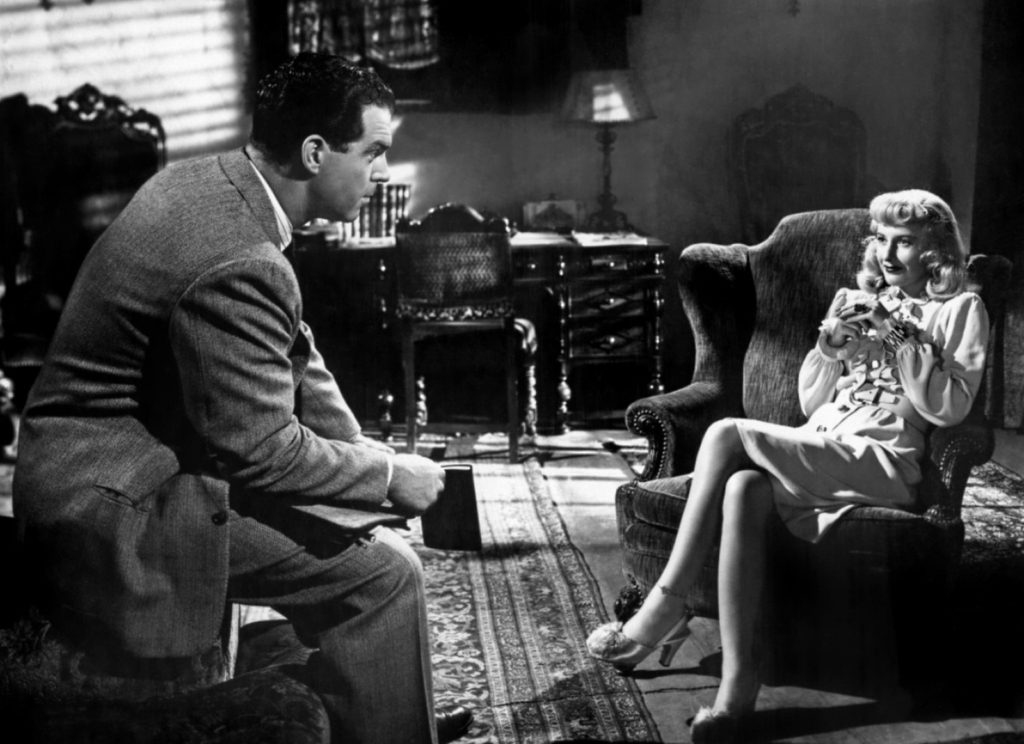
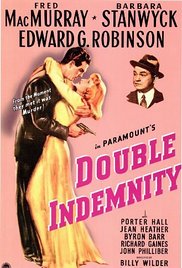 “I’m crazy about you, Baby!”
“I’m crazy about you, Baby!”
There are multiple reason to watch Double Indemnity this weekend, but I will watch it over and over again for the word play alone. For example, “Walter: You’ll be here too?” Phyllis: “I guess so, I usually am.” Walter: “Same chair, same perfume, same anklet?” Phyllis: “I wonder if I know what you mean.” Walter: “I wonder if you wonder.” It’s brilliant and dark, sarcastic, funny and sad all in the same scene. The director, Billy Wilder (Sunset Boulevard, Some Like It Hot) delivers a story that is full of twists and turns and is intriguing from the opening scene. Walter Neff sits at a desk, he is worn and tired and has a gunshot wound in his shoulder. He starts to record his story and says, “I suppose you’ll call this a confession when you hear it…. Yes I killed him, killed him for money, killed him for a woman. Well I didn’t get the money and I didn’t get the woman.” Good grief! That is how it starts? What a great set up for a film.
Double Indemnity is the story of Walter Neff, Fred MacMurray, an insurance salesman that is manipulated into helping Phyllis Dietrichson, the beautiful Barbara Stanwyck, to kill her husband for accident insurance money. The scheme and murder go just as planned but then everything falls apart when Walter’s insurance manager Barton Keyes, the brilliant Edward G. Robinson, starts to investigate.
Phyllis is strong, cool, and manipulative while Walter burns hot, and is weak and impetuous. To balance out these two main characters you have the analytical and unrelenting Keyes. The dialogue and interaction between these three is a total dance and every step is perfect. The writing by Wilder and Raymond Chandler combined with the delivery from Stanwyck, MacMurray and Robinson produces a clever and sarcastic rhythm. The story is full of twists and turns that keep you glued to the film until those final words “I love you, too”. This 1940’s Film Noir crime drama is a great example of character development, and it’s a well-told story. It’s manipulative and dark but in all the rights ways.
The Strange Love of Martha Ivers
(1946, Hal Wallis Productions, dir. Lewis Milestone)
by Sharon Autenrieth
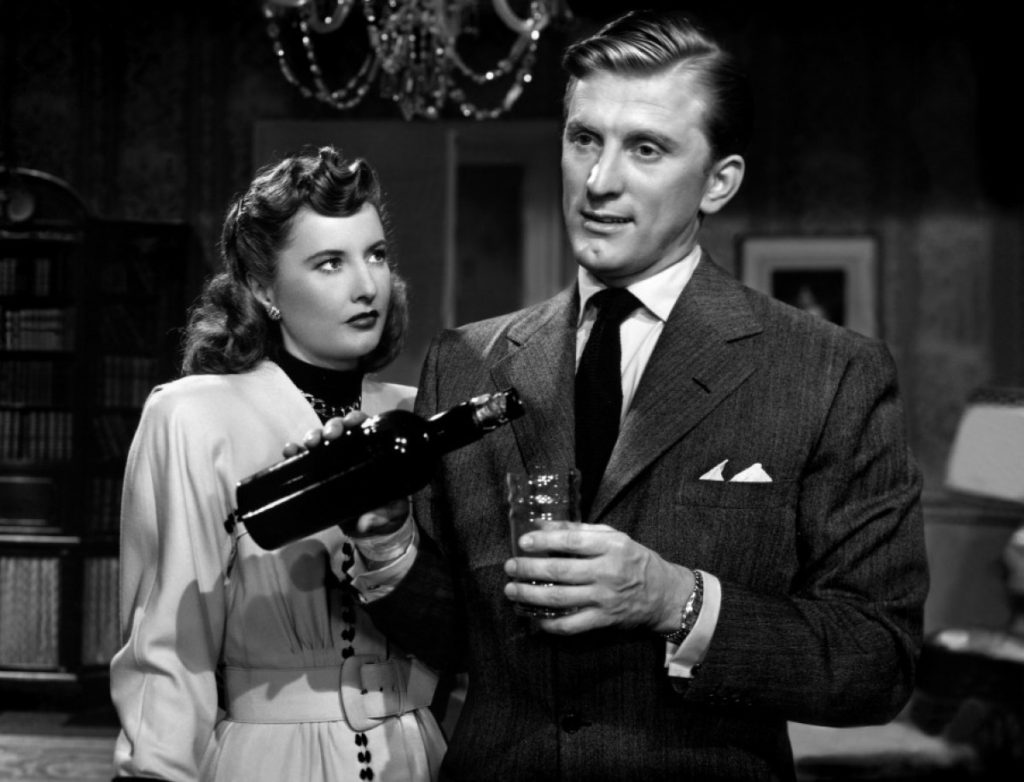
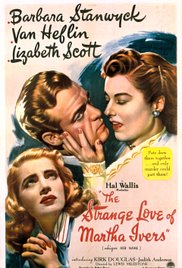 Barbara Stanwyck was certainly beautiful, but there was something distinctive about that beauty; something sharp and icy; brittle, like a shard of glass that could be used to slit your throat. In some movies, like Ball of Fire or The Lady Eve, she is seductive and wisecracking, but ultimately goodhearted. The sweet, hapless leading men are won over by her, but she is equally won over by their sweetness.
Barbara Stanwyck was certainly beautiful, but there was something distinctive about that beauty; something sharp and icy; brittle, like a shard of glass that could be used to slit your throat. In some movies, like Ball of Fire or The Lady Eve, she is seductive and wisecracking, but ultimately goodhearted. The sweet, hapless leading men are won over by her, but she is equally won over by their sweetness.
And then there’s the other Barbara Stanwyck: the throat-slitting version. That’s who we get in The Strange Love of Martha Ivers. Martha (Stanwyck) is both the heir of the wealthiest family in a small industrial town, and a captain of industry in her own right. What haunts her is the murder of her aunt, played by one of cinema’s great villainesses, Judith Anderson. Sure, Martha was provoked, but still – she’d hate, hate, hated her aunt and wasn’t sorry when she was gone. The murder is known only to her childhood friends Walter and Sam (or so Martha believes) – one a bit of a nerd, the other a rebel and a roughneck. They both love her, but Sam disappears at the time of the murder. Walter, on the other hand, stays. Not only does he lie for Martha, but he will eventually see that another man goes to the gallows for her aunt’s death.
That’s the set up for bringing these characters back together as adults. Martha and Walter (Kirk Douglas) are miserably married: Sam (Van Heflin) is a wanderer, a gambler with a checkered past who has just found another woman worth his time (Lizabeth Scott). Seeing each other for the first time in 18 years reignites not just fear of blackmail in these old friends (Is that why Sam has returned?) but loads of sexual tension.
This was Kirk Douglas’s first role, and it’s strange to see him playing a character who is weak, fearful and no match for his romantic rival. Heflin is the tarnished hero of this film, and Lizabeth Scott, with her perfect features and husky voice, seems like the easy choice for Sam. But Stanwyck has her own power, always. She walks into every room as if she owns it, takes charge of every man, dismisses Scott with contempt. If she is defeated, it will be on her own terms.
The Strange Love of Martha Ivers is perhaps a second-tier film noir, but it’s an effective little work of darkness. It’s the sort of movie in which an admission of murder is followed immediately by lovemaking – and because it all seems to be driven by “how badly people want what they want”, to quote Walter, the violence and sex seem fitting partners.
The Lady Eve
(1941, Paramount Pictures, dir. Preston Sturges)
by Jim Tudor
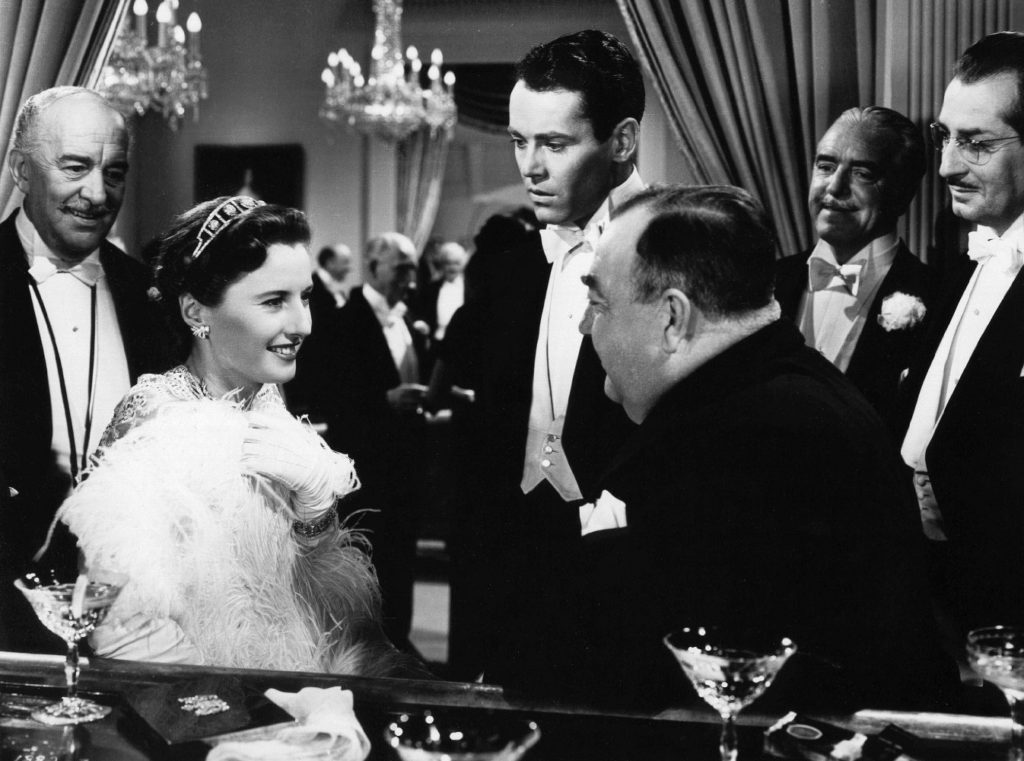
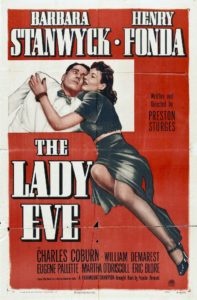 “I need him like the ax needs the turkey.”
“I need him like the ax needs the turkey.”
I was in college when I first encountered Barbara Stanwyck. It was a course devoted to Film Noir, and they showed us Double Indemnity – a film I’d never heard of. With no small thanks to Stanwyck’s seductively icy turn as Phyllis Dietrichson, Double Indemnity shot into my personal list of Top Five Favorite Movies. In fact, she was so amazing as this deadliest of femmes fatales, that perhaps that goes a short way in explaining why I didn’t immediately go immerse myself in Stanwyck’s quite sizable, long running, and impressive filmography. When I caught wind of the fact that she was wearing a blonde wig in Double Indemnity, I admit I was a little disappointed. I wanted to keep her in my mind as Mrs. Dietrichson, that conniving snake of a woman.
Three years before she took that trip straight down the line for Billy Wilder, another smart-comedy master writer/director had her tripping Henry Fonda as a fatale of a different color. In the comedy brilliance that is Preston Sturges’ The Lady Eve, Stanwyck’s card sharping title character sinks her loveable fangs into Fonda’s naïve reptile wrangling millionaire. She’s following in her confidence man father’s footsteps, looking for rich patsys to hustle on luxury cruise ships. The apple not only doesn’t fall far from the tree, in this case, it falls right on Fonda’s head. She aims to please, and she certainly comes through. She may not be the prettiest woman on the ship, but she’s certainly the most irresistible; just forward enough to cause a fella to stammer.
Sturges crafted The Lady Eve with a visionary and narrative boldness rare in early 1940s Hollywood. This is not a static film by any measure, yet, long unbroken close-up two-shots are a repeated motif. It’s always Stanwyck holding Fonda romantically close, or vice versa. By the third or forth time, even Sturges has grown impatient with the identity-challenged ups and downs of these lovers, and allows a mischievous horse to steal the scene. Calling him “Hopsi”, Stanwyck reels him in early on, making the professional mistake of falling in love with him for real. But when he finds out who she really is, he bolts, and she vows to get him back – in more ways than one! She later adopts a different identity, and like Kim Novak in Vertigo seventeen years later, her allure transcends identification. Because of her, “Hopsi” is clobbered, walloped, soaked, tripped, soaked again, and bonked throughout the movie. But, she can’t be that much of a snake lady – after all, she can’t stand the slimy creatures. When she spies Fonda’s slithery pet loose on the floor, she suddenly looses it, scream-running all the way through the ship. Straight down the line.
Stella Dallas
(1937, Samuel Goldwyn Productions, dir. King Vidor)
by Robert Hornak
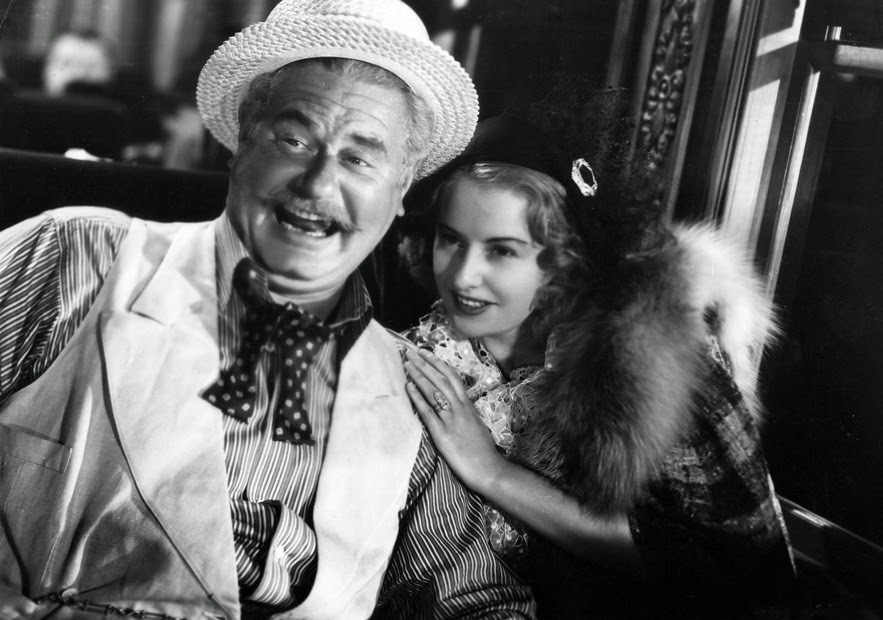
 I love these movies that flip a person’s utter rejection of responsibility into a climactic moment of personal triumph. Suppose to an extent, it’s the usual peanut butter cup for movies of that era: one part Dream Factory, happy ending mythologizing, one part Hays Code dicta requiring the bad girl to get hers in the end. The two together force you to feel good about someone who you wouldn’t invite to your backyard barbeque. But the biggest part of the whitewash in the case of Stella Dallas can’t be helped, deeply imbued as it with the skeptical, small-eyed intensity of Barbara Stanwyck. She stands there in whatever padding and garish costuming they’ve picked for her, for one stretch looking every bit like Harpo in drag, and she still can’t be anything but a rigid conductor of withering certitude. Even in her broadest moments of childish impudence and foot-stamping snittiness, when we’re supposed to most want to slap her entitlement down, she vibrates with a willful intelligence that seems to, at first, justify all, or at the very least make us believe her choices are something more than pure selfishness. Then there’s that flat, almost adenoidal baritone, breaking through the clutter of other characters’ protestations with the sharpness of a knowing mother or accusing lover – her voice has the timbre of authority that puts everyone else on the spot, no matter her behavior, wondering if maybe they had the situation wrong and should have studied harder before approaching her.
I love these movies that flip a person’s utter rejection of responsibility into a climactic moment of personal triumph. Suppose to an extent, it’s the usual peanut butter cup for movies of that era: one part Dream Factory, happy ending mythologizing, one part Hays Code dicta requiring the bad girl to get hers in the end. The two together force you to feel good about someone who you wouldn’t invite to your backyard barbeque. But the biggest part of the whitewash in the case of Stella Dallas can’t be helped, deeply imbued as it with the skeptical, small-eyed intensity of Barbara Stanwyck. She stands there in whatever padding and garish costuming they’ve picked for her, for one stretch looking every bit like Harpo in drag, and she still can’t be anything but a rigid conductor of withering certitude. Even in her broadest moments of childish impudence and foot-stamping snittiness, when we’re supposed to most want to slap her entitlement down, she vibrates with a willful intelligence that seems to, at first, justify all, or at the very least make us believe her choices are something more than pure selfishness. Then there’s that flat, almost adenoidal baritone, breaking through the clutter of other characters’ protestations with the sharpness of a knowing mother or accusing lover – her voice has the timbre of authority that puts everyone else on the spot, no matter her behavior, wondering if maybe they had the situation wrong and should have studied harder before approaching her.
The bulwark Stanwyck presence single-handedly helps to soften the blow of Stella’s immorality, helps to curb the blunt force of a character who’s a case study in ambition gone awry, whose final walk toward the camera, with music swelling and smile spreading, is underneath it all a stunning portrait of self-deluded failure. After Stella’s first gambit lands her in the lap of luxury, and after which she promptly goes collecting other laps, she finds herself an unwilling mom. For at least part of an act she gives the responsibility thing the old college try, but despite some moments of real mother-daughter bonding, it proves too much for her. By the end of this 15-year slab of life, and after a circumstance of convenience affords her a killer out – dump the teen with her dad and wonderful new step-mom – Stanwyck has brought enough of herself to the party to let us feel for her personal loss even over such a brutally cold-hearted machination. The height of this sequence is a brilliant scene depicting the daughter, Laurel, in a moment of indecision over which parents’ house to live in, and Stella purposely laying on thick the uncaring, dismissive, self-involved act, in hopes her antics will make the girl choose her dad – this, it’s communicated to us quite movingly, is because Stella knows in her heart Laurel will be better off without her. But we’ve already been convinced by Stella that her overriding need is to be free again. We’re with Stella insofar as we’re caught up in the pathos generated by Stanwyck’s teary authenticity, but we’re also left in the end with the knowledge that Stella’s so-called selfless act has just handed Laurel a burning ember of hate that’ll never die, and enough abandonment issues to fill a sequel with bitter comeuppance.


